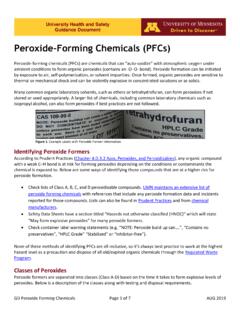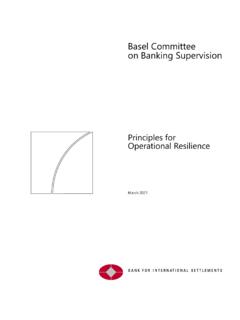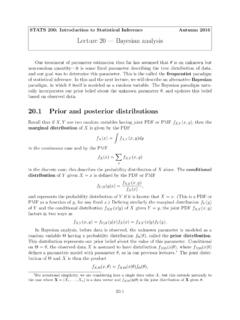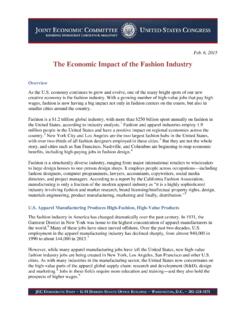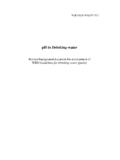Transcription of Truss Design Example - University of Alabama
1 CE 331, Fall 2000 Truss Design Example 1 / 8 Design a typical steel Truss girder to support the roof of the office building shown below. Fy = 36 ksi Purlins are Z 7 x light gage steel, weighing lb/ft Use WT sections for the chords, double angles (LL) for the verticals, and single angels (L) for the diagonals. Roof: Composition 4-ply felt & gravel 18 ga metal deck fiberglass insulation gravel and bitumen waterproofing membrane Ceiling: acoustic tile suspended steel channel 6 @ 10 ft = 60 ft 2 @ 10 ft = 20 ft 20 ft 20 ft 15 ft 6 @ 10 ft = 60 ft 2 @ 10 ft = 20 ft 20 ft Plan View Front Elevation CE 331, Fall 2000 Truss Design Example 2 / 8 Calculate Dead Loads Composition 4-ply felt and gravel psf 18 ga metal deck psf Fiberglass insulation psf Gravel Bitumin Waterproofing psf Acoustic Tile psf Suspended Steel Channel psf Total psf PDL_int = psf x 10 ft x 20 ft + lb/ft x 20 ft = k PDL_ext = psf x 5 ft x 20 ft + lb/ft x 20 ft = k Find chord with the max.
2 Bar force (assume compression controls) Model Truss on RISA: 1. Open new file in RISA Setup 2. Select 1st item on "Data Entry" menu, "Global", and select "2" for "Number of Sections" 3. Select 2nd item on "Data Entry" menu, "Materials" and select correct yield stress, "Fy" (default = 36 ksi which is what is specified for this homework). 4. Select 4th item on "Data Entry" menu, "Sections", and specify three sections, labeled "Chords", "Verticals", and "Diagonals". Do not specify shapes at this time. Draw Members 5. Select "Modify the drawing grid" from graphic editing tool bar and create grid (8@10 for the X-axis and 1@6 for the Y-axis).
3 6. Select "Draw new members" from the graphic editing tool bar, select "Chords" under "Section Set" and select "Bending Moments Released (torsion fixed)" under both "I-end Release Codes" and "J-end Release Codes". 7. Draw chords. 8. Repeat steps 6 and 7 for the verticals and the diagonals. 9. Select "Save As" under the "File" menu and save your model. Modify Boundary Conditions 10. Select "Modify Boundary Conditions" from the graphic editing toolbar. 11. Specify "Fixed" and click the "Use" box for the last for boundary conditions (Z-Translation, X Rotation, Y Rotation and Z Rotation) , select the "Apply entries to all selected items" button and click "Apply".
4 12. Specify "Reaction" and click the "Use" box for the first two boundary conditions (X-Translation and Y-Translation), select the "Apply Entries by Clicking them Individually" button, click "Apply" and click on the node at the pinned support. 13. Specify "Free" for the first boundary condition (X-Translation), click "Apply" and click on the node at the pinned support. CE 331, Fall 2000 Truss Design Example 3 / 8 Apply Dead Load and Solve 14. Select the Basic Load Case button on the top tool bar and type "Dead Loads" on the first line under "BLC Description" 15. Select the "Apply joint loads" button on the graphic editing tool bar and select" "Y" for Direction " " for Magnitude "1: Dead Loads" for Basic Load Case "Apply Entry by Clicking Items Individually", and the "Apply" button 16.
5 Select the nodes that have the external point loads applied 17. Repeat steps 15 and 16 for the internal point loads 18. Select the "Load Combinations" button on the top tool bar and type "DL Only" under "Description", "1" under "BLC" and "1" under "Factor". 19. Select the solve button ("=") on the top tool bar, select "Single Combination" and "1: DL Only" and select the "Solve" button. 20. Check to make sure that the Total Y reaction ( k) equals the sum of the loads 2 x k + 7 x k = k, OK Find Max. Bar Force and Document Results 21. Find the max. compressive chord force (+'ve in RISA) by Selecting just the chords (first "unselect" the entire Truss , then select just the chords by drawing a box around first the top and then the bottom chords).
6 Use the selection tools on the toolbar along the left edge of the screen. Click the "Exclude" button in the bottom-left corner of the screen Select "Member Forces" on the "Results" toolbar (only the members representing chords should be shown), click on the column marked "Axis [K]", and select "sort" from the menu which appears by right-clicking. At the top of the list should be the member corresponding to your top chord in the 3rd panel with a bar force of " k". 22. Document your results. RISA model of Truss showing dead loads and member numbers CE 331, Fall 2000 Truss Design Example 4 / 8 Chord Forces due to Dead Load (max = k in member 11) Member Label Sec Axial, K M1 1 2 M2 1 2 M3 1 2 M4 1 2 M5 1 2 M6 1 2 M7 1 2 M8 1 2 M9 1 2 M10 1 2 M11 1 2 M12 1 2 M13 1 2 M14 1 2 M15 1 2 M16 1 2 CE 331, Fall 2000 Truss Design Example 5 / 8 Determine Live-Load Span Loading to cause Max.
7 Force in Member 11 (Member 11 is the top chord of panel 3 in this RISA model) 23. Construct influence diagram for member 11 by applying distributed temperature load to member 11 of 1"/( E-6 x 10 ft x 12 in/ft) = 1282 oF. 24. Click on "Dist. Patterns" in the "Data Entry" menu and on the second line (the line below "Uniform") type "Temperature", "T", "1", and "1" in the first four columns. 25. Create a basic load case for the influence diagram by typing "Influence for mem 11" on the second line of the "Basic Load Case" menu. 26. Bring up the "Member Distributed Loads" menu by clicking on the cell under "Dist" in the second line of the Basic Load Case menu and select or type "M11", "Temperature" and "1282" in the first three columns.
8 A "1" should appear in the cell you selected of the "Basic Load Case" menu. 27. Create a load combination for the influence diagram by opening the "Load Combinations" sheet and typing "Influence for 11", "2" and "1" in the 1st, 7th and 8th columns, respectively. 28. Compute the influence diagram by clicking on the "=" button and selecting "Single Combination" and "2: Influence for 11" and then "Solve". 29. Display the influence diagram by opening the plot options menu (press "F2" or click the "blue box" button in the upper left (two buttons below the "File" menu)). Select the "Load Combination" button and the "Include Undeflected Shadow" button.
9 30. Printout the influence diagram for member 11 and label appropriately (in pencil, write: Influence Diagram for Member 11). Influence Diagram for Member 11 Compute Bar Forces due to Live Load 31. Create a Basic Load Case for the Live Load on Span 1 by opening the BLC sheet and typing LL on Span 1 only on the 3rd line. 32. Repeat steps 15 through 17 to place the external and internal concentrated loads on the left-most 7 joints. (The loads over the support will have no effect on the bar force in member 11, but they will affect the bar forces in the verticals and diagonals near the supports). Show the live loading to cause max.
10 Force in member 11. CE 331, Fall 2000 Truss Design_Example 6 / 8 Live Loads to Cause Max. Force in Member 11 Calculate Chord Forces due to Dead + Live Loads33. Create a Load Combination for DL + LL by typing "DL + LL on span 1", "1", "1", "3", "1"on the third line of the "Load Combination" sheet in columns 1 and 7 through 10, Select the solve button ("=") on the top tool bar, select "Single Combination" and "3: DL +LL on Span 1" and select the "Solve" Check to make sure that the Total Y reaction ( k) equals the sum of the loadsDL: 2 x k + 7 x k = kLL: k + 6 x k = kTotal: k, OK36.







